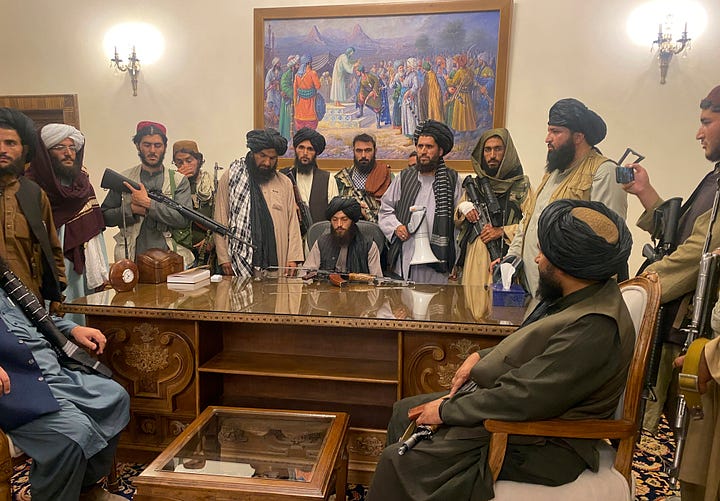The following is the third of the three articles titled “Taliban Terror.”
Over twenty years of occupation, the Middle Eastern nation of Afghanistan slept under the warm blanket of American liberty. Girls were able to attend school. They could aspire to work as doctors, lawyers, engineers, journalists, and public servants. In American hands, those young girls had a promising future. But this era came to an abrupt halt when the Taliban seized power in 2021.
Women’s rights
Initially, the Taliban regime assured the international community that women would no longer be deprived of educational and employment opportunities. It did not take long before these empty promises would be revoked. The Taliban banned any schooling of girls beyond the sixth grade. They claimed it was temporary. In March of 2022, as a new semester was about to begin, the Taliban announced that schools would reopen. After waiting nearly seven months, teachers and students headed to school. They were disappointed to learn that the Taliban had reversed the decision. Everyone was ordered to go home. In response, women’s activists have flooded the streets, demanding equality in education. Large protests were organized at Kabul, waving the flag of the former US-backed Afghan government. To protest the Taliban’s tyranny is an act of defiance that risks one’s life. In December of 2022, the Taliban went even further. Women were prohibited from attending university.
The Trump Era
By 2016, a growing number of Americans were fed up with Afghanistan. Many believed that the war was no longer in the United States’ best interest, and was far too expensive. Donald Trump tapped into this frustration with nation-building, pledging himself to an “America First” foreign policy. “Afghanistan is a total and complete disaster,” the reality star-turned-presidential candidate complained. “What are we doing? We can’t even run our own country. We don’t build our schools. We don’t build our highways. Money should be spent in our country.” Trump was determined to negotiate a deal, and bring a speedy end to America’s foreign entanglements. The president ordered American ambassadors to prepare a withdrawal agreement. Secret negotiations with the Taliban were resumed in Doha. The Afghan government was kept out of the deliberations, and only learned of them after news of the talks leaked. President Ghani was outraged. Ghani’s administration felt that the secret negotiations had undercut and delegitimized their own regime. In their view, it gave the Taliban a dangerous legitimacy. But President Trump was eager to end the war. “If we wanted to fight a war in Afghanistan and win it, I could win that war in a week,” he told the press from the White House. “I just don’t want to kill ten million people.”
Doha Agreement
In a matter of months, the Trump administration hastily drafted an agreement with Taliban representatives for an eventual peace deal. Ghani’s government were still shut out from those deliberations. They included a proposed ceasefire and troop withdrawals, as well as a power-sharing arrangement between the Taliban and Ghani’s government. Soon after agreeing, the Taliban introduced their own conditions for talking with Ghani. Their demands grew increasingly outrageous. Ghani rejected any offers for a prisoner exchange. Overriding Ghani’s vehement objections, the Trump administration pushed ahead. What resulted was a historic peace agreement on February 29, 2020. The US agreed to a full withdrawal by May of 2021, while the Taliban promised not to harbor any foreign terrorist groups. But they would not agree to denounce al-Qaeda and bin Laden. The agreement also stipulated that Ghana release 5,000 prisoners over two weeks. Under the Doha deal, the Taliban agreed to a ceasefire with Americans, but did not do so with Ghani’s forces. Ghani remained resolutely opposed to the agreement. He refused to commit to any release of prisoners. Negotiations stalled, and violence ignited. 55 terrorist attacks were carried out daily. Afghan casualties doubled. But under major diplomatic pressure from the US, Ghani acquiesced to the deal. After the release of the 5,000 prisoners, the Taliban finally agreed to talk to Ghani. Secretary of State Mike Pompeo arrived at Doha to initiate the intra-Afghan talks. For the first time in forty years, Afghans on the two sides were in negotiations. But the talks went nowhere. It was clear that the Taliban were not interested in sharing power. Ghani’s negotiators tried to gain concessions from the Taliban, such as the freedom of the press and women’s rights. The Taliban relied on cunning propaganda, which gave the illusion that they were willing to accept women’s rights. But this was not true. The Taliban had no reason to make any such concessions. They had already won the release of their prisoners, and the Americans were on their way out in a matter of months.
Biden’s withdrawal
When Biden came into office in 2021, he announced he would stick with Trump’s withdrawal deal. But the new president did push back the date from May to September. Over the course of four months, the Taliban launched an aggressive offensive that completely seized power. Any attempts at a coalition government were utterly dashed. The Taliban began by conquering the rural areas, and seizing control of the highways. They continued to rapidly gain ground throughout April and May. By late June, they had captured over 150 of the 407 districts. The speedy victories were gloatingly filmed and propagated by Taliban state media. They seized thousands of weapons and loads of ammunition, and began closing in on provincial capitals. This was all in total violation of the Doha Agreement. In a last-ditch effort, President Ghani flew to Washington. He sought Biden’s assurances for continued US support. Ghani presented himself as a modern-day Abraham Lincoln, defending his republican regime from violent extremists. Biden pledged his support. For months, the Pentagon had repeatedly assured Ghani that the US would continue its engagement with Afghanistan in other ways. Regardless, on July 2, 2021, the US pulled out of Bagram Airbase. Over 700 bases were closed down. All forms of support were pulled out. Amid public pressure, Biden assured the media that the Afghan security forces were prepared to fend off the Taliban. But the situation was hopeless. Many Afghan soldiers simply surrendered to the Taliban. By the end of July, over 223 districts were in Taliban hands. Going into August, the Biden administration still expressed optimism about a power-sharing agreement. They blamed the Afghan government for failing to defend their country. On August 8, the first provincial capital fell. It was Kunduz. By August 12, 17 of the 34 provincial capitals had fallen. This included Kandahar, the second largest city in the country. Hundreds of terrorists were released from jail. In the west, Afghanistan’s third largest city, called Herat, fell. By mid-August, the Taliban were active in over 85% of the country. Kabul was in their sight. The panicked Pentagon did everything it could to manage the embarrassment. President Ghani attempted to reassure the residents of Kabul. But it was futile. Panic broke out in the capital. Ghani was worried too. The last president to face a Taliban takeover had been castrated, dragged through the streets, and hung outside the palace. The Taliban marched triumphantly into Kabul on the morning of August 15, 2021. Ghani fled to neighboring Uzbekistan. Within hours, the Taliban had breached the presidential compound. When they reached Ghani’s desk, the jihadists recited Quranic verses gloatingly. Although the Taliban had promised a peaceful coup, the chaos and confusion led them to quickly resort to violence. The Kabul Airport was the one area still controlled by US forces. The US airlifted over 120,000 Coalition and Afghan civilians to safety. Tens of thousands of special visa immigrants were left behind. Shocking footage showed Afghans plunging to their death as they desperately clung on to the fleeing US airplanes. Comparisons were immediately made to Saigon. In the face of widespread criticism, President Biden defiantly defended his decision. He blamed Ghani and his government. Ten days after Biden’s speech, a suicide bomber assaulted the huge crowd at the airport. Videos online showed piles of dead bodies. Around 170 Afghans, and 13 Americans, died in the bombing. A rival of the Taliban, calling itself ISIS-K, claimed responsibility. The US responded with a retaliatory drone strike against a suspicious van, which only killed 10 more innocent Afghans. Among the dead were seven innocent children. The Pentagon’s investigation found that no ISIS militants had been struck. It was yet another humiliating embarrassment for the US.
Mission failed
The last US troops left on August 30, 2021. America’s longest war had finally ended. Nearly 2,400 brave soldiers died in the fight for freedom against the Taliban in Afghanistan. Another 3,900 American contractors had died too. Over 115,000 Afghan fighters from both sides were killed, along with nearly 50,000 Afghan civilians. Over two trillion dollars were spent. Even with all those of brave sacrifices, Afghanistan has regressed to exactly what it was before the US invasion in the wake of 9/11. The Taliban rule over a pariah state, the only country in the world where women are denied an education. Most women are not allowed to work. Strict dress codes are imposed. Most music is banned. Independent news outlets have all been closed down. Homosexuality is punishable by death. Executions by hanging are performed publicly. Even worse, the Taliban continues to maintain its ties to al-Qaeda. When a US drone strike took out bin Laden’s successor, al-Zawahiri, in July of 2022, the al-Qaeda leader had been living in a residence owned by the Taliban’s Interior Minister. Over a million Afghans have fled the country. Thousands more are trying to escape every day.


Learn More





